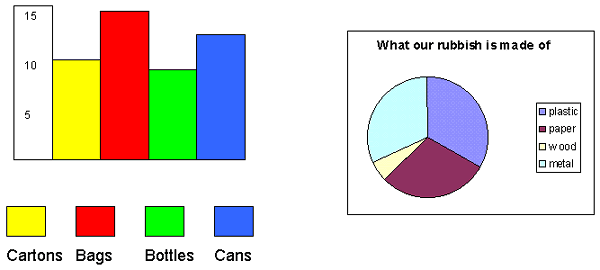Title: What does our rubbish tell us?
(an activity to raise awareness of the environmental issues centred around rubbish)
Activity: Children investigate the rubbish collected in their houses over the weekend.
Resources: Rubbish, any graphing program which allows the creation of bar and pie charts or a spreadsheet
What to do: Each child is given a plastic rubbish
sack into which they collect the family's rubbish over the weekend. (wrappings, cartons
and containers).
STRESS THIS MUST BE CLEAN RUBBISH - NO WASTE FOOD OR OTHER PERISHABLES. NO GLASS. ALL
BOTTLES AND CANS MUST BE WASHED AND CONTAIN NO JAGGED EDGES.
In groups children observe, describe, sort and count their rubbish, sorting on various criteria: e.g. type, use, material, disposable, recyclable. Using the graphing program they present their findings in graph form and analyse the results.
Sorting can then be extended by taking one group of the objects, e.g. cardboard items, cans or cartons and sorting, possibly taking taking information from the packages.

Extension activities: This activity can be a starting point to numerous activities in mathematics, science and D & T. Many environmental issues can be investigated.
A database of all the different types of rubbish can be created so connections can be made, for example, between the use of the item and material used, size and contents and volume -- depending on the age and abilities of the pupils.
Items can be dismantled to reveal nets. Children can then use drawing programs to investigate nets.
Children can devise tests to determine the strength of cartons and carrier bags.
IT Capability: handling Information level 2 or 3. Level 4 and 5 can also be achieved with more complex lines of enquiry.